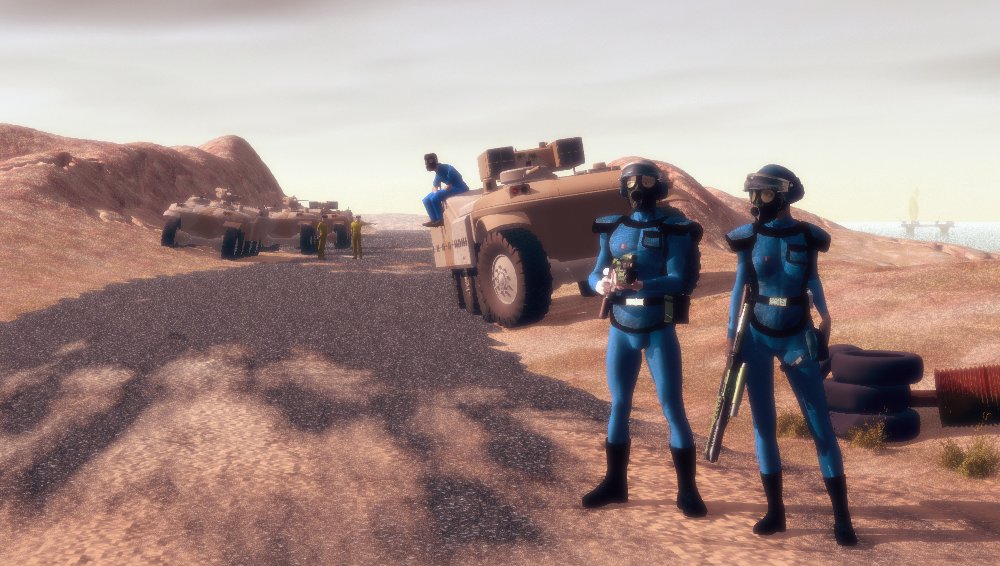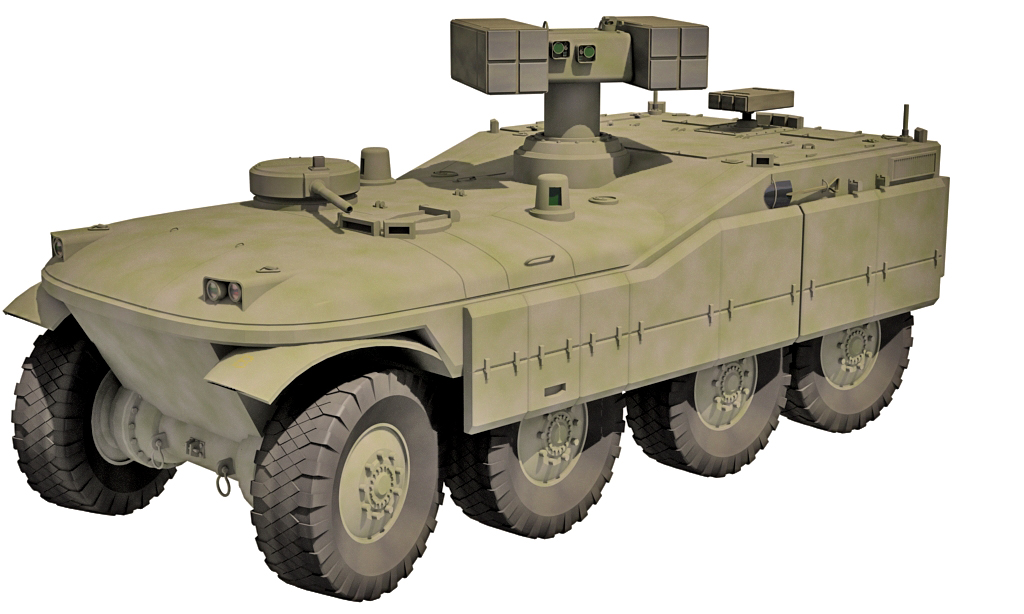
|
EBR-97 Introduction The EBR-97 is France’s much needed replacement for the
obsolete ABR-76 and VCIR which is coming into
service with frontline French Army units. Like its predecessor it is
a robust and versatile eight wheeled AFV capable
of undertaking a range of tasks. The EBR-97 is a notably capable vehicle
able to survive and thrive on a medium intensity battlefield. The EBR-97
has seen service against the Kafers in the hands of the Troupes de Marine
and the Coloniale and many units are rebuilding
with this vehicle. No doubt it will also prove a popular export item.
Acknowledgement All images are by Laurent Esmiol.
The 30mm MDAC and M-79 are by Bryn Monnery. Narrative The
four vehicle section rolled east through the streets of Adrian pushing
out the perimeter into one of the shattered and deserted suburbs. The
‘malheureux’ of the 2e Division d’Infanterie
de Marine had arrived from the Continent Français only two days before
to take over from the motley garrison of New African
conscripts and Adrianer résistants. The once graceful city of Adrian
was still in a state of fear. The under strength, overstretched and
under trained New African 71st Brigade had done its best but was unable
to secure anything but key points in the city. Only now had the situation
elsewhere on Beta Canum calmed down enough to allow the dispatch a full
formation of regulars. During the Occupation the British had launched a major raid on Adrian which had killed most of the garrison but the Kafer Remnants had reformed effectively thereafter in the face of increasing opposition from the resistance. It was only after the 3rd Liberation that the British eventually launched the Raven Brigade, the 71st Brigade and a group of Commandos from New Woking to try and liberate the city. They’d done their job, beating the Kafer main force but the Ravens had to re-deploy before the city was properly secured, leaving the New Africans and Adrianers to it. The
Néo-Provençal marsouins were crack
veterans of Kimanjano and Beta Canum and experts at hunting down the
aliens. They’d quickly come to rely on their new EBR-97s for protection
and firepower, something they could never have said about their old
VCIRs and ABR-76s. Seconds after the small convoy turned off
the Rue Evans they came under a hail of gunfire. The
response was almost instantaneous as 7.5mm and 30mm fire rocked away
from the EBR-97s scattering the exposed Kafers forcing the survivors
into bomb damaged buildings. One of the vehicles fired a FAE
blockbuster in after them, smashing them with a killing concussion.
The vehicles pulled into formation as more Kafers began opening up.
Now came the difficult bit as the rear ramps whirred open and marines
stormed out to root out the alien fighters. As they did so other sections
of EBR-97s from I/13e RIMa raced to the scene to
cut off the Kafers’ escape routes.
|
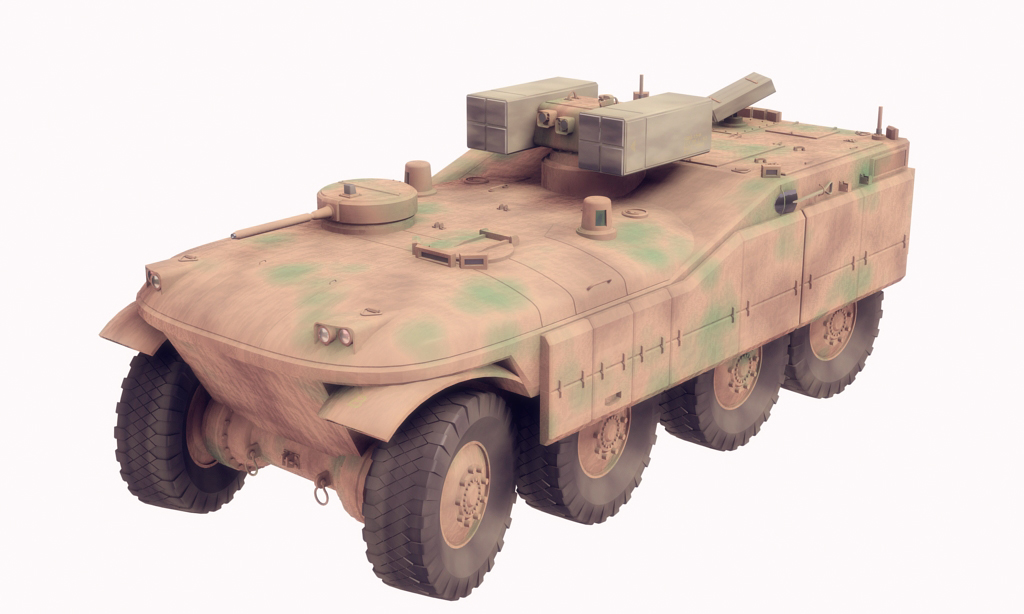
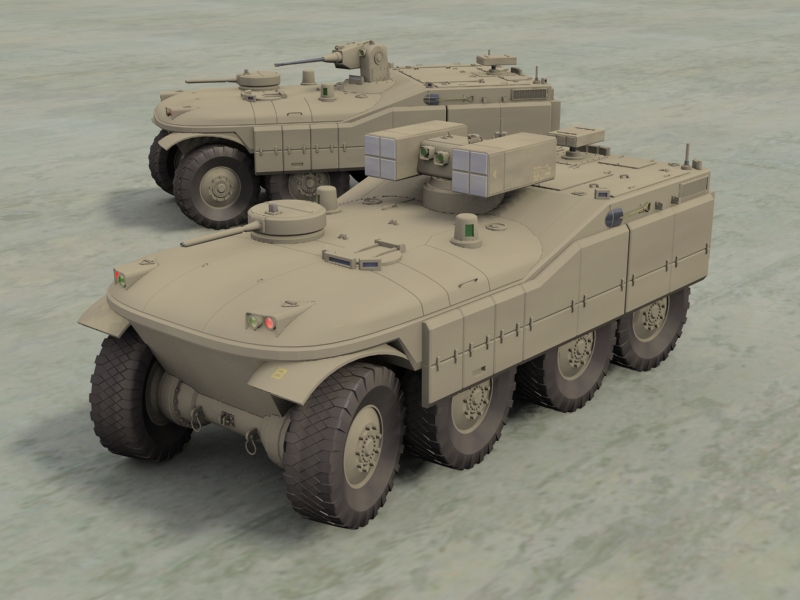
|
EBR de Combat-97 The EBRC-97 is designed as a direct fire tank destroyer to supplement the EBRA-97 and has had the most troubled gestation of any of the EBR-97 models. The EBRC-97 carries a converted Darlan 65mm MDC from the AC-12 in a remote mounting, together with a pair of Martel missiles, in place of the 30mm. The vehicle also has 4 Manta missiles in a vertical launch system in the rear. The EBRC-97 has no troop carrying capacity and there has been some trouble integrating the MDC and the EBRC-97 is only just reaching frontline units. Schneider are producing an export version substituting the commonly used CLP-1A. EBR de
Poste de Commandement-97 EBRPC-97
is a HQ and command vehicle found at company HQ level and above. It
retains the 30mm MDAC but has an extensive
command, communications and control system installed which reduces the
carrying capacity to 4 passengers. EBR d’Ambulance - 97 This
is the ambulance version of the EBR-97 and does not mount the 30mm MDAC. It carries four lightweight Automeds
and two medical orderlies. EBR d’Echelon de Dépannage-97 This
is the repair and recovery version and has a rear mounted crane and
spare parts storage. Four mechanics can be carried. EBR d’Echelon Logistique-97 The
EBRL-97 is the workhorse of the series, and is designed to support all
the other versions in combat. The EBREL-97 has a redesigned rear troop
compartment with loading rails to allow logistic packages to be quickly
loaded and unloaded. It is also capable of being equipped with fuel
tankage. EBR de Mortier-97 The EBRM-97 is an indirect fire support version of the EBR-97. It carries a turret mounted standard French 105mm automatic mortar, by using a turret mounted weapon the EBRM-97 is dramatically more versatile than the ABR-76M it replaces being able to engage targets with indirect fire as well. Schneider are producing a range of prototypes with different auto-mortars in a range of calibres installed. |
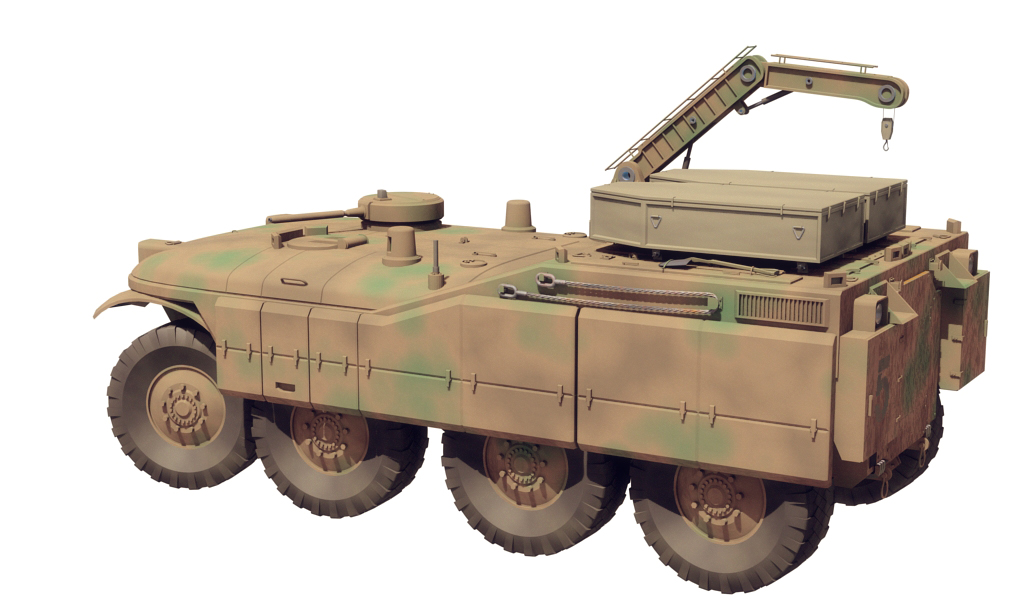
|
M-79 General Purpose Machine Gun EBRR-97, 1e Escadron, 2e Régiment de Chasseurs de Kimanjano, 209e Division
d’Infanterie Côte
d’Enfer, Fromme,
Kimanjano, 19th January 2303 |
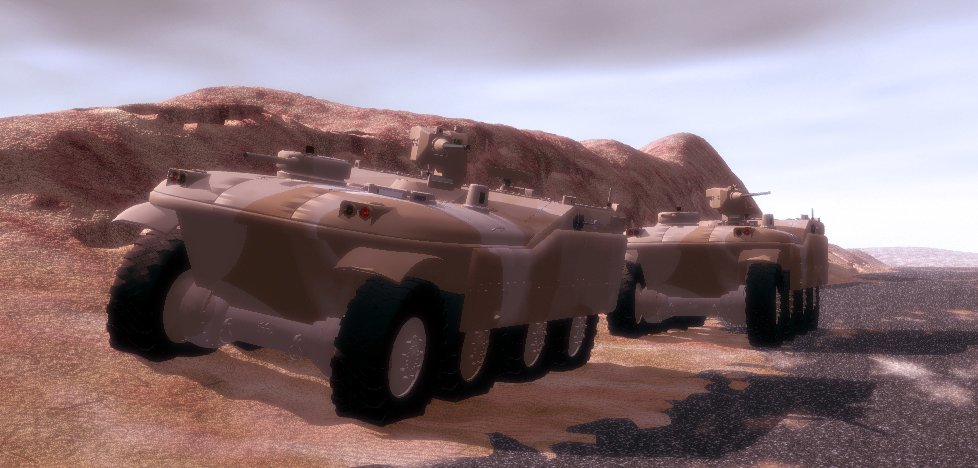
|
The
2e RCK are a unit of the Milice
Coloniale who were formed in the aftermath
of the Liberation of Kimanjano from members of the Francs-Tireurs
de Kimanjano and a training cadre from the Coloniale.
2e RCK is to provide the reconnaissance element
of the rebuilt 209e DI. The regiment was fortunate enough to receive
a complete equipment set of EBR-97s in the autumn of 2302 and has been
working hard to get up to speed with this equipment. EBRA-97, II Bataillon, 13e Régiment d’Infanterie
de Marines, 2e Division d’Infanterie de Marine Adrian,
Southern Continent, BCV-4, 2nd November 2302 |
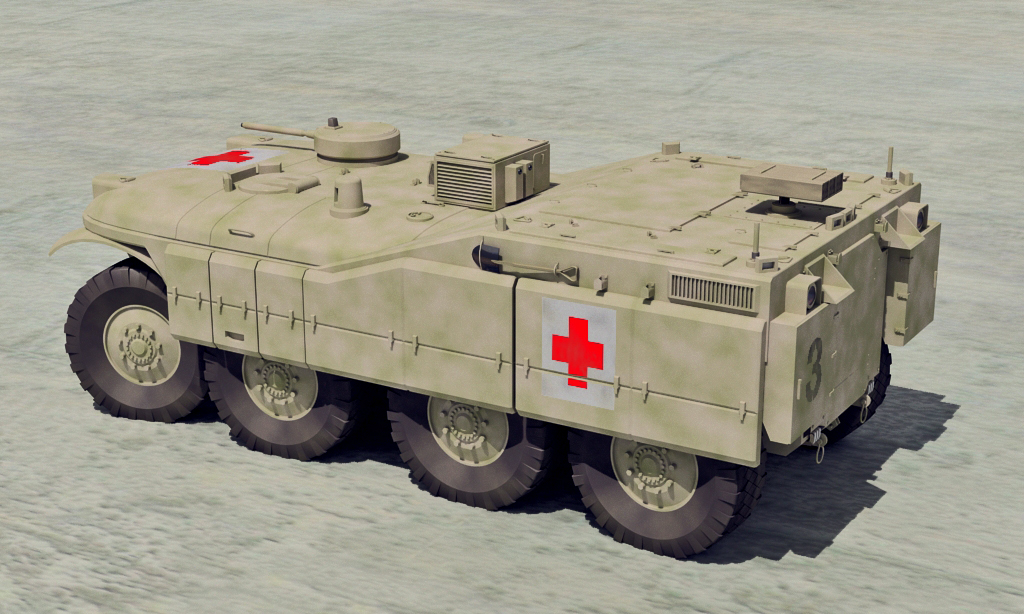
|
This
EBRA-97 belongs to the malheureux
of the 2e DIMa’s II/13e RIMa.
A rapid reaction unit tasked mainly with medium intensity warfare, which
nevertheless has seen heavy combat in the Libération of the French Arm.
This EBRA-97 is assigned to II/13e RIMa’s
medical platoon and has seen heavy use in the months preceding this
photo. The
image was taken during operations in Adrian. At this time most of the
Kafers had been purged from the city and the 2e DIMa
was primarily engaged in patrolling to secure the city and relief operations.
2e DIMa was notable for retaining their original
Néo-Provençal camouflage patterns throughout
the campaign. They even carried red crosses on their ambulances, almost
unheard of units operating in the Cluster during the Invasion but fairly
common in Armée de Libération units. The EBRA-97 is characterised by
the lack of an MDAC and the mounting of a
filtration and air conditioning unit on the roof. EBRCI-97,
I Bataillon, 2e Zouaves d'Algérie, 101e Division d’Infanterie
Algeria,
Earth, 11th December 2302 |
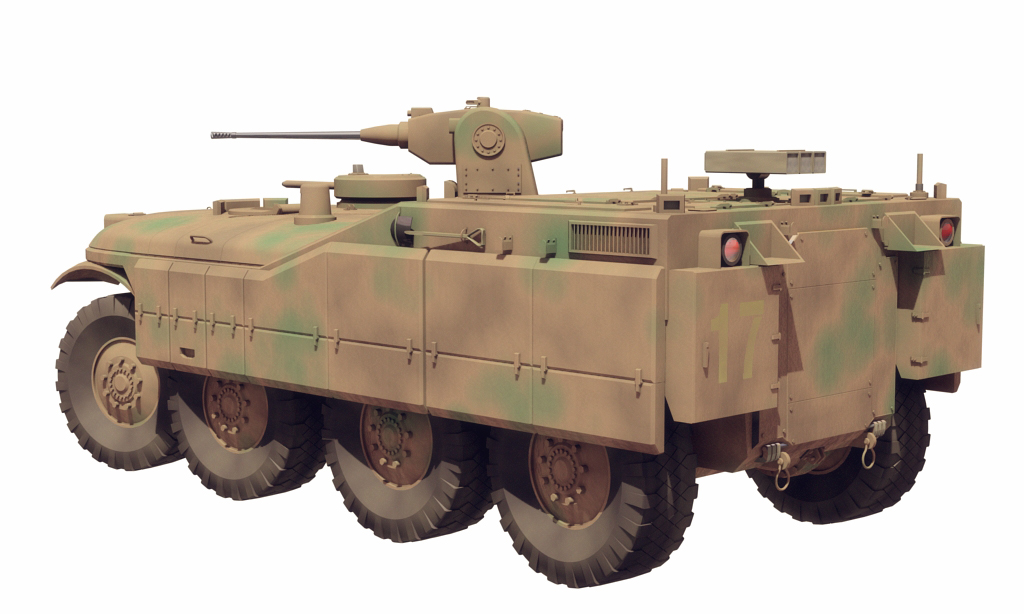
|
This
EBRCI-97 belongs to the Algerian 2e Zouaves.
The unit is shown here on exercise in the coastal regions of North Africa
in the process of conducting build-up training prior to deployment to
the Central Asian Republic on ‘peacekeeping’ duties. Algerian units
of the 4e Corps have been repeatedly called upon to bolster other French
formations and rightly regard themselves as a
hard fighting elite within the French Army. The EBRCI-97 is shown in
typical 4e Corps camouflage pattern which is also used by French AFVs
of the Armée de l’Asie Centrale.
EBRC-97, 1e Bataillon, Régiment de Chasseurs Ardennais, 64e Division d’Infanterie
Champagne,
France, Earth, 26th February 2303 |
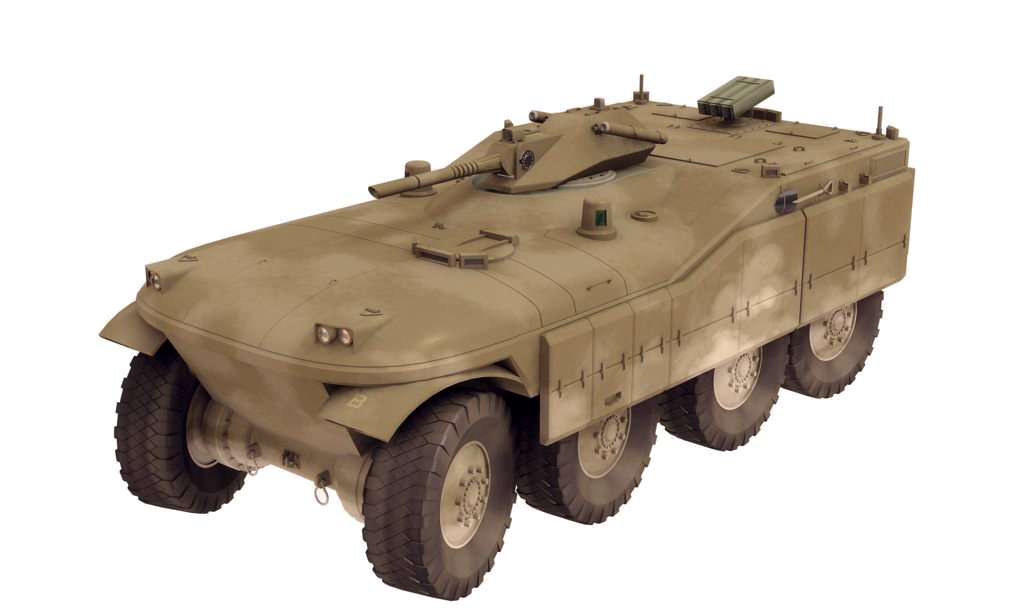
|
This EBRC-97 is newly issue with the famous 1e Chasseurs Ardennais, a Voluntary Nation Service unit assigned to the 64e DI. The 64e DI is a Belgian formation and was badly mauled trying to defend the Ardennes from the German assault in 2293 and so has been one of the first Armée Territoriale de l'Hexegone units to receive the EBR-97. This EBRC-97 is shown on exercise at the Mourmelon training camp in Champagne in early 2303 and is painted in a dark green pattern used in northern France. Notable is the white chalk dust thrown up on the skirts, a signature mark of most training in Champagne.
EBRA-97,
Otaku Models - 2299 Catalogue |
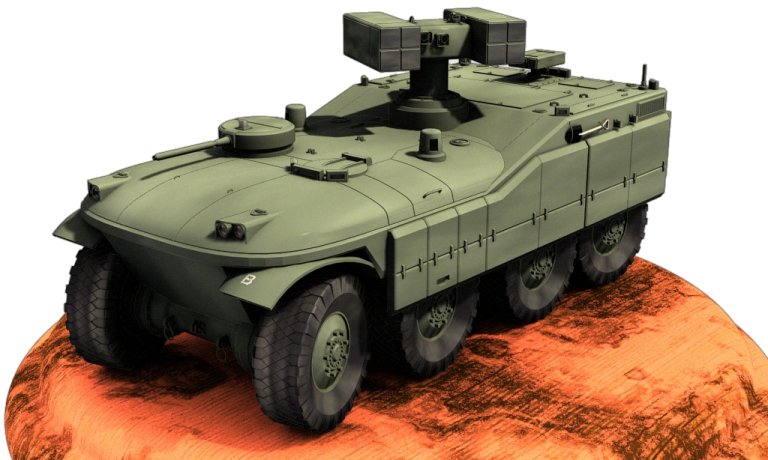
|
Modelling
of AFVs, both digitally on computers as well
as in plastics and other mediums, is a popular, if niche, pastime in
2300. Japan based Otaku Models has established itself as a market leader
in such models since the time of the Central Asian War. Shown here is
one of their earliest models of an EBRA-97 shown in basic green factory
finish and mounted on a wooden base.
The
ABR-76’s place in canon is somewhat confused. Its title suggests an
in service (or at least procurement) date of 2276 yet the Ground Vehicle
Guide describes it as an export design pressed into service during the
War of German Reunification. By the Aurore Sourcebook the vehicle
is still in service in colonial and some Metropolitan units in 2300.
I have chosen to introduce the vehicle in 2276 and have it see service
in the wars with Manchurian, Germany and the Kafers, by which date it
is a very tired design indeed and past due for replacement.
The
Aurore S/B also describes regular French ABR-76 units containing ABRs and unarmoured range trucks.
I found this to be somewhat counter intuitive for such a major power
and at odds with most current practice (i.e. real life UK armoured recce
using different models of CVR(T)s – Scimitars,
Spartans, Strikers etc) and so introduced a light wheeled APC,
the VCIR, to compliment the ABR-76. Canon
purists should feel free to ignore these changes.
8
September 2004 Copyright
2004, Laurent Esmiol and D Hebditch |
